Key takeaways:
- Integrating student interests into lessons enhances engagement and transforms mundane topics into exciting learning experiences.
- Informal surveys, one-on-one conversations, and observations during free play are effective methods for uncovering student interests.
- Creating interest-based projects stimulates creativity, deepens understanding, and connects students personally to the curriculum.
- Adjusting the curriculum to reflect student preferences fosters passion and improves engagement, leading to better educational outcomes.
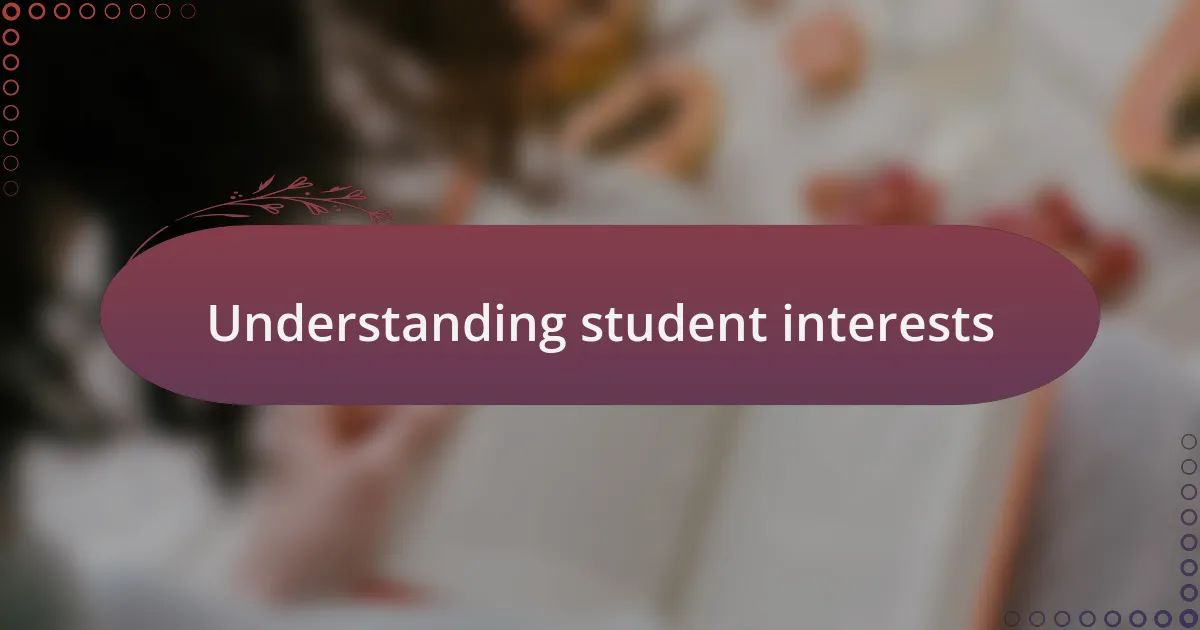
Understanding student interests
Understanding student interests is essential for creating engaging educational experiences. I remember a time when I had a student who was deeply fascinated by video games. By weaving game mechanics into learning activities, I watched their motivation soar; it was like flipping a switch. Isn’t it interesting how integrating student interests can transform a mundane lesson into an exhilarating adventure?
When we take the time to listen to our students, we’re not just collecting data; we’re building connections. I once asked my class about their favorite hobbies and was surprised to discover that many of them loved nature photography. This insight led me to incorporate outdoor projects that not only aligned with curriculum goals but also fueled their enthusiasm. How often do we overlook these golden opportunities to bridge personal interests with educational content?
Exploring interests can be eye-opening. I often conduct informal surveys or discussions to uncover what sparks my students’ curiosity. One year, a simple question about favorite movies opened the door to a rich multimedia project that combined storytelling and technology. Isn’t it profound that something as simple as a movie can lead to deeper learning? Understanding these interests allows us to create an environment where students feel seen, valued, and eager to engage.
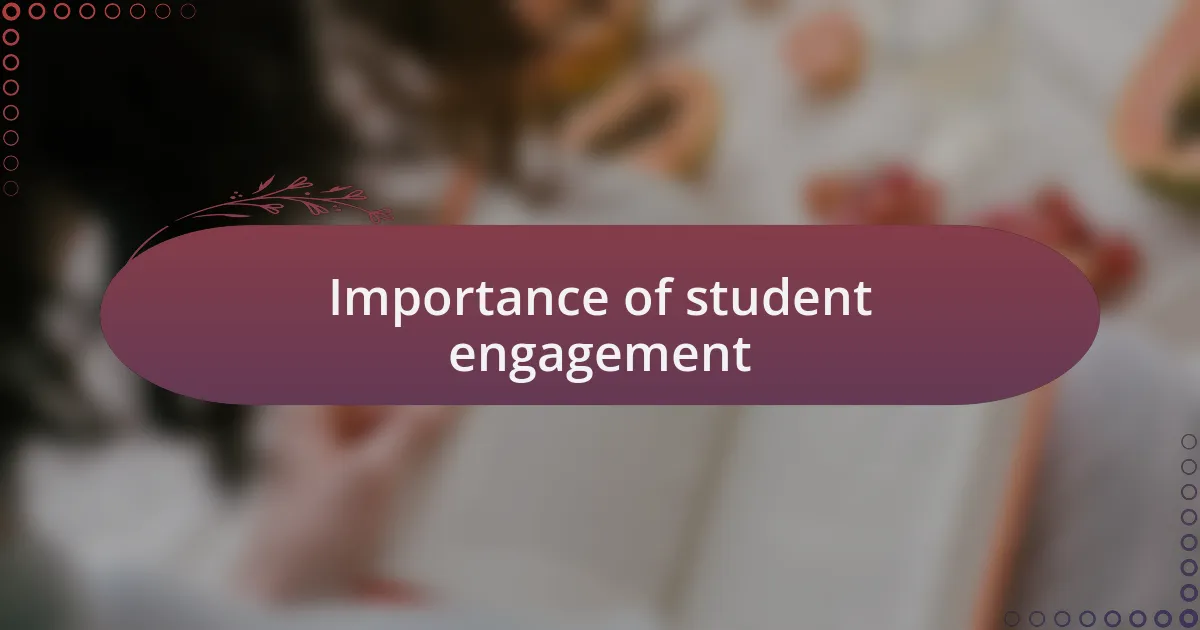
Importance of student engagement
Engaging students is not merely about delivering content; it’s about fostering a sense of belonging and excitement in the learning process. I recall a moment when I introduced a project based on a student’s passion for robotics. It was incredible to watch the entire class become energized, collaborating enthusiastically as they designed their own robotic creations. Have you ever witnessed that kind of electricity in a classroom? It’s this kind of engagement that transforms learning from a chore into a vibrant experience.
Moreover, when students feel engaged, they tend to retain information more effectively. Last year, I integrated a student’s love for graphic novels into a reading comprehension unit. Instead of standard texts, we analyzed graphic novels that aligned with our themes, and the improvement in their understanding was remarkable. Isn’t it fascinating how something they enjoy can cast the material in a new light, significantly enhancing their analytical skills?
Ultimately, student engagement fuels curiosity and a desire for exploration. I once saw firsthand how bringing in elements of art into math lessons sparked a wave of creativity and problem-solving among my students. The excitement in the room was palpable as they painted visual representations of mathematical concepts. How often do we miss out on this magical interplay that can make learning not just a job, but a joyful journey?
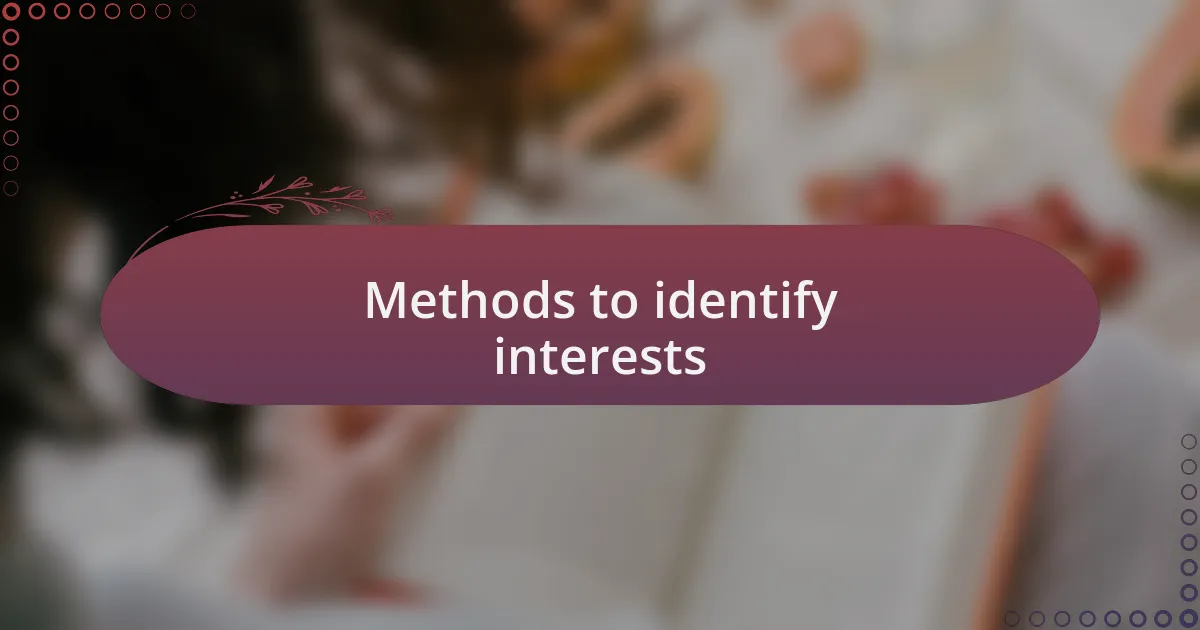
Methods to identify interests
When identifying student interests, I find informal surveys to be incredibly effective. These quick questionnaires not only provide insight into what students enjoy, but they also foster a sense of ownership in their learning journey. I remember handing out a simple form asking about hobbies and favorite subjects; the results were eye-opening and even surprising to me. How enlightening can it be when a quiet student reveals a deep passion for astronomy through their responses?
Another valuable method I employ is conducting one-on-one conversations. Spending just a few moments chatting with students, I can often uncover their hidden interests. In one of these chats, a student casually mentioned their enthusiasm for coding games. It led to a mini-project that not only engaged them but also inspired their classmates. Isn’t it amazing how a single conversation can spark a wave of creativity?
Finally, observing students during free choice activities is a goldmine for discovering their interests. I remember watching a group of kids choose to build a model city during a play period. Their collaborative spirit and discussions opened up insights into their fascination with architecture and urban planning. Isn’t it interesting how much we can learn just by watching them immerse themselves in play?
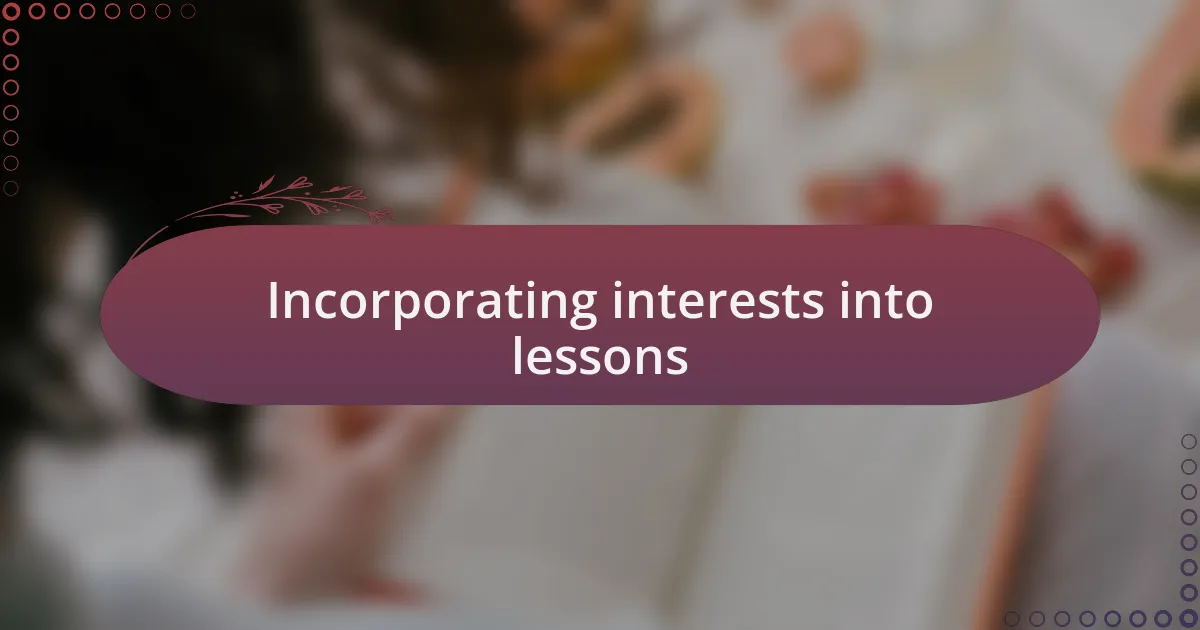
Incorporating interests into lessons
Incorporating student interests into lessons not only enhances engagement but also makes learning relevant. One experience that stands out to me is when I developed a history lesson around popular video games. After learning that many students were avid gamers, I created a project where they could explore the historical contexts of their favorite games. It was inspiring to see how their excitement for gaming translated into a deeper understanding of historical events. How often do we underestimate the power of blending interests with curriculum?
Another approach I’ve found effective is integrating students’ hobbies into group projects. For instance, when a few students expressed their love for environmental science through a school garden initiative, I allowed them to lead a class project focusing on sustainability. The passion they displayed while sharing their ideas was contagious, and it created a collaborative spirit that enriched not just their learning but that of their peers. It felt like a win-win; students were invested because their interests guided the learning experience.
Additionally, I like to weave in current events related to topics students are passionate about. Once, after discussing climate change, a student shared an article about a young activist making waves globally. This prompted a lively debate that not only informed my lesson on civic responsibility but also gave students a platform to voice their opinions. Isn’t it rewarding when students can connect classroom discussions to real-world issues that matter to them? This connection fosters critical thinking and cultivates a sense of agency in their learning.
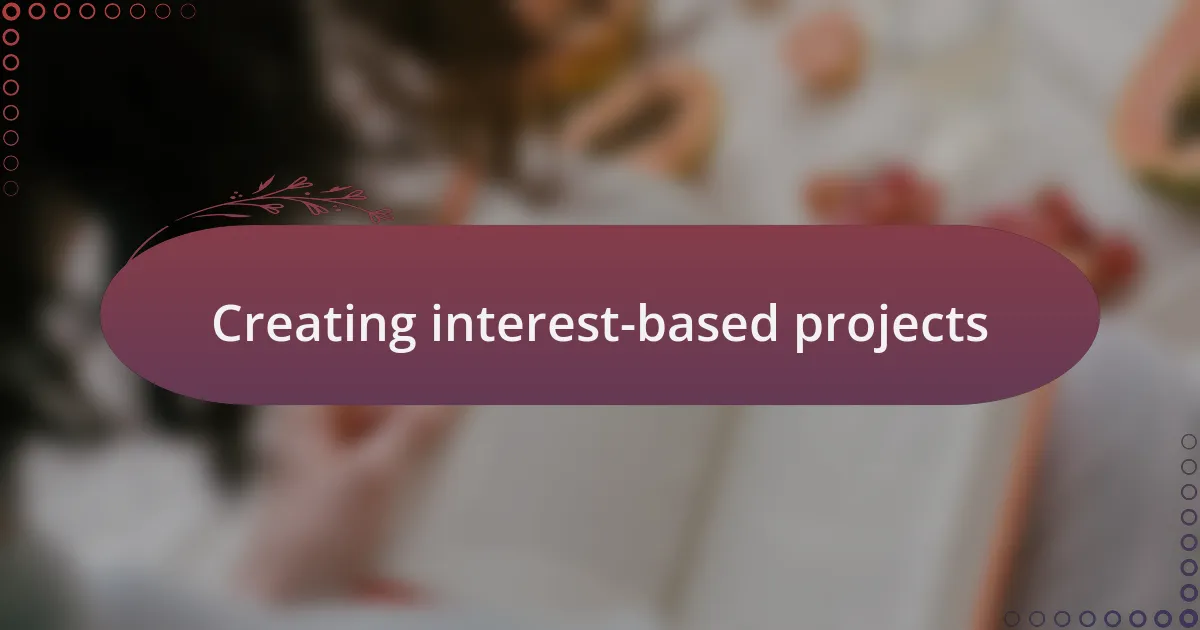
Creating interest-based projects
Creating interest-based projects can be a transformative experience for both students and educators. I recall a time when my students were fascinated by space exploration. I encouraged them to collaborate on a project that involved designing their own planets and ecosystems. Seeing their imaginations take flight was exhilarating; I could feel their enthusiasm as they worked together, blending creativity with scientific concepts. How incredible is it when students channel their interests into such immersive learning experiences?
Another memorable project emerged when students expressed a passion for storytelling and digital media. I set up a project where they created their own podcasts on topics they loved, ranging from local history to fantasy worlds. It was amazing to witness their self-confidence grow as they scripted, recorded, and edited their work. The excitement in the classroom was palpable. Have you ever noticed how personal investment can ignite a passion for learning?
I’ve found that tapping into these interests leads to deeper connections with the curriculum. One year, I introduced a project centered around student-created documentaries about community heroes. The emotional responses were profound. Students not only learned valuable research skills but also began to appreciate the stories and struggles of those around them. It made me realize that when students are allowed to explore what matters to them, they don’t just learn; they thrive. Isn’t that the ultimate goal of education?

Adjusting curriculum for student preferences
Adjusting the curriculum to align with student preferences has been a game changer in my teaching practice. I remember a class where many students expressed a strong interest in environmental issues. By weaving these topics into our science lessons, I noticed an immediate shift in engagement. How rewarding is it to see students so passionate about discussing sustainability and conservation, knowing they are contributing to a cause they genuinely care about?
One strategy I’ve utilized is incorporating choice into assessments. For instance, when we covered literature, I allowed students to select the format for a final project—whether it was a creative presentation, a visual art piece, or a written analysis. This flexibility transformed the atmosphere; students seemed more focused and motivated. Have you ever seen how a simple option can empower learners and bring out their best work?
Furthermore, I often hold informal discussions to gauge my students’ hobbies and interests. I recall one lively conversation about technology that sparked an idea for a unit on coding. By doing this, I ensure that the curriculum feels relevant and dynamic, reflecting students’ lives. Isn’t it fascinating how personal connections can turn a standard lesson into an unforgettable experience?
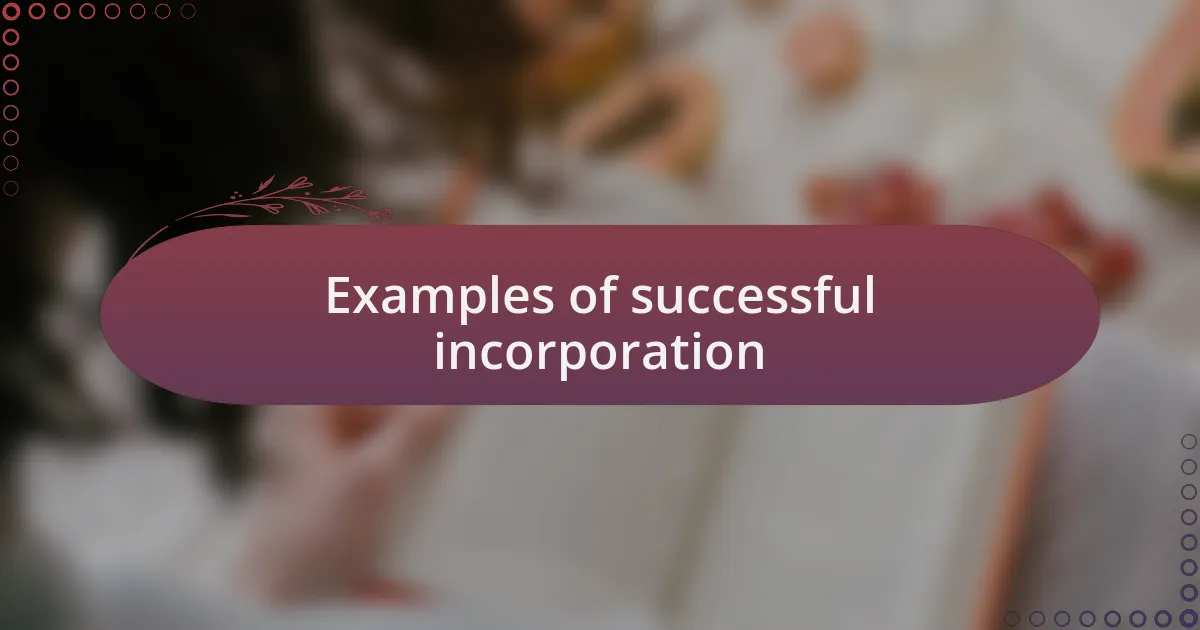
Examples of successful incorporation
One of the most effective examples I’ve seen involved a history unit centered around local community stories. When I invited students to investigate their family histories, I was amazed at the enthusiasm that emerged. Each student brought in unique narratives, sharing tales that connected us all in unexpected ways. Did you ever notice how telling personal stories can transform historical lessons into something deeply relatable?
Another approach I adopted was integrating popular culture into mathematics. I remember designing a project where students analyzed the statistics of their favorite sports teams. This not only made the math more appealing but also allowed students to apply their passion for sports in a practical way. Have you ever seen students blossom when they can connect what they love to what they’re learning?
In a recent science unit, I incorporated student-driven research projects on renewable energy sources. Encouraging students to explore topics like solar panels and wind turbines ignited their curiosity and motivation. All it took was a little shift towards focusing on their interests, and suddenly, the classroom buzzed with enthusiasm. Isn’t it amazing how empowering students to follow their passions can foster a rich learning environment?